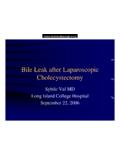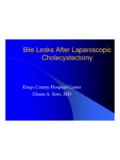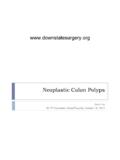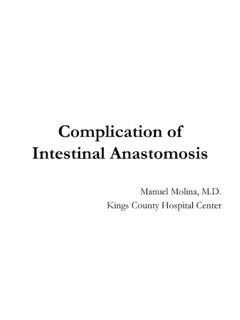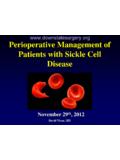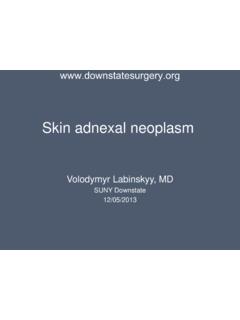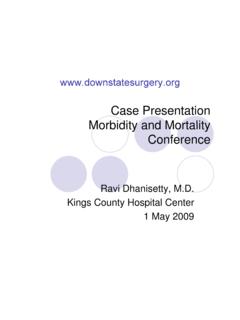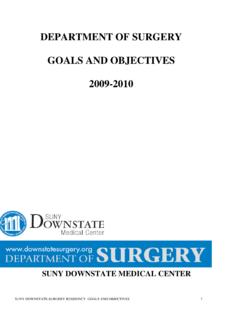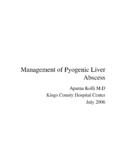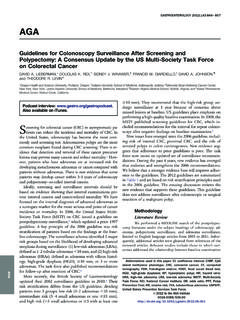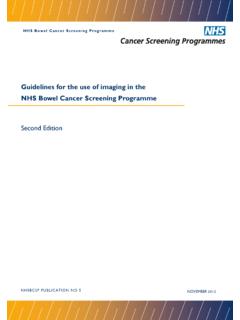Transcription of Georges E Al-Khoury MD Kings County Hospital …
1 Case PresentationCase PresentationGeorges E AlGeorges E Al--KhouryKhouryMDMDK ings County Hospital CenterKings County Hospital Center4/22/20054/22/2005 Management of Management of Duodenal TumorsDuodenal TumorsGeorges E AlGeorges E Al--KhouryKhouryMDMD4/22/20054/22/2005 Duodenal TumorsDuodenal Tumors The duodenum is the shortest segment of the small The duodenum is the shortest segment of the small intestine but may be affected by a wide variety of intestine but may be affected by a wide variety of primary and secondary primary and secondary neoplasmsneoplasms Benign : Benign : adenoma, adenoma, leiomyomaleiomyoma, , lipomalipoma Malignant : Malignant : adenocarcinomaadenocarcinoma, , carcinoidcarcinoid, lymphoma, , lymphoma, leiomyosarcomaleiomyosarcomaDuodenal TumorsDuodenal Tumors Primary tumors of the duodenum are Primary tumors of the duodenum are uncommon.
2 Uncommon. Peak incidence : 6th and 8th decade of lifePeak incidence : 6th and 8th decade of lifeThe Etiology of DT is unknownThe Etiology of DT is unknownProtective factors ?Protective factors ? SecretorySecretoryimmunoglobulinsimmunog lobulins Small intestinal Small intestinal hydroxylaseshydroxylases((could inactivate potential could inactivate potential carcinogenscarcinogens)) Alkalinity in the duodenumAlkalinity in the duodenum((could prevent formation of could prevent formation of potential carcinogenspotential carcinogens)) Rapid transit of liquid bowel contentsRapid transit of liquid bowel contents Lack of bacteriaLack of bacteriaSymptoms are related to the tumor locationSymptoms are related to the tumor location N ,V N ,V PainPain Jaundice Jaundice Anemia Anemia PancreatitisPancreatitis HematemesisHematemesis MelenaMelena Palpable mass Palpable mass Obstruction Obstruction Weight loss Weight loss IntussusceptionIntussusception CholangitisCholangitisBenign Duodenal TumorsBenign Duodenal TumorsAdenomasAdenomas The most common benign tumors in the The most common benign tumors in the duodenum duodenum Present either as : Present either as.
3 AdenomatousAdenomatouspolyps polyps Brunner's gland adenomas Brunner's gland adenomas Villous adenomasVillous adenomas((high rate of malignant high rate of malignant transformation transformation ))AdenomatousAdenomatouspolypspolyps Sessile, nodular or Sessile, nodular or pedunculatedpedunculated.. Most are asymptomaticMost are asymptomatic PeriampullaryPeriampullarylesions may cause lesions may cause intermittent jaundice or intermittent jaundice or pancreatitispancreatitis.. Anemia may also occur secondary to chronic Anemia may also occur secondary to chronic blood loss.
4 Duodenal Duodenal adenomatousadenomatouspolyps are common polyps are common in FAP and Gardner's syndrome in FAP and Gardner's syndrome AdenomatousAdenomatouspolypspolyps Adenomatous polyps are most often at the gastroduodenal junction For the small polyps ( < 2 cm), standard abdominal CT may not be able to demonstrate the lesions clearlyAdenomatousAdenomatouspolypspolyp sSessile or pedunculatedintraluminal filling defects are usually depicted on barium studiesSporadic duodenal adenoma (DA) 7% of duodenal polyps ( of 378 duodenal polyps found at 25 000 EGD were adenomatous) Predominance at the ampulla and periampullary regionSporadic DA is associated with colorectal neoplasiaSporadic duodenal adenoma (DA) Colonoscopy is indicated for all DA to benign duodenal polypsApproach to benign duodenal polyps Any Any pedunculatedpedunculatedlesion is removed by using a lesion is removed by using a snare.
5 Snare. If tumors < 1 cm If tumors < 1 cm snare snare polypectomypolypectomy Small single sessile polyps or multiple small polyps Small single sessile polyps or multiple small polyps argon plasma coagulator. argon plasma coagulator. EndoscopicEndoscopicUS is helpful in any sessile lesion where US is helpful in any sessile lesion where invasion is is suspected. Large flat polyps are removed by piecemeal Large flat polyps are removed by piecemeal polypectomypolypectomyLaparoscopic resection of a Laparoscopic resection of a periampullaryperiampullaryvillous adenomavillous adenoma Criteria for Criteria for endoscopicendoscopicsnare snare papillectomypapillectomyof of papillary adenomas:papillary adenomas.
6 (1) < 4 cm (1) < 4 cm (2) (regular margin, no ulceration, soft consistency) (2) (regular margin, no ulceration, soft consistency) (3) benign (3) benign histologichistologicfindings findings (4) absence of (4) absence of intraductalintraductalinvolvement as involvement as demonstrated by ERCP/demonstrated by ERCP/endoscopicendoscopicultrasound . ultrasound . Recurrence rates of 19%Recurrence rates of 19%--26%, within 1 year of 26%, within 1 year of polypectomypolypectomyApproach to benign duodenal polypsApproach to benign duodenal polyps Criteria for surgery : Criteria for surgery.
7 (1) large polyp (1(1) large polyp (1--3 cm in size) 3 cm in size) (2) a polyp in which EUS shows deeper tumor (2) a polyp in which EUS shows deeper tumor infiltration infiltration (4) polyp with severe (4) polyp with severe dysplasiadysplasiaor or carcinomatouscarcinomatousinfiltration infiltration (5) recurrence of the polyp after complete (5) recurrence of the polyp after complete to benign duodenal polypsApproach to benign duodenal polyps The surgical procedure of choice should be The surgical procedure of choice should be segmental duodenal resection or segmental duodenal resection or transduodenaltransduodenalpolypectomypol ypectomywhen feasiblewhen feasible Lesions located in D1 are well suited for Lesions located in D1 are well suited for transduodenaltransduodenalpolypectomypol ypectomybecause the duodenum because the duodenum can be closed with can be closed with pyloroplastypyloroplastyavoiding luminal avoiding luminal narrowing narrowing Segmental resection should be undertaken if simple Segmental resection should be
8 Undertaken if simple closure would induce luminal narrowing (D3,D4)closure would induce luminal narrowing (D3,D4)TransgastricTransgastricEndolumin alEndoluminalLaparoscopic Laparoscopic Resection of a Duodenal PolypResection of a Duodenal Polyp Laparoscopic Laparoscopic procedure used to procedure used to treat gastric lesions treat gastric lesions such as polyps and such as polyps and carcinoma in in situ. This approach can also This approach can also be used to treat be used to treat proximal duodenal proximal duodenal problems such as problems such as bleeding and polyps. bleeding and polyps. Duodenal adenomatosis in FAPUp to 95% of pts with FAP develop duodenal polypsDuodenal adenomatosis in FAP Adenoma carcinoma sequence (like colonic polyps) Lifetime risk of 3 5% of duodenal cancer Prophylactic colectomy the incidence of colorectal cancer, duodenal cancer (330 x the population risk) and desmoid disease are now the leading causes of death in adenomatosis in FAP The incidence and severity of adenomatosis increase with age.
9 Duodenal adenomatosis in FAPD uodenal adenomatosis in FAP Even flat duodenal mucosa in patients with FAP had high proliferative activitiesDuodenal adenomatosis in FAPS tage IV duodenal adenomatosis with bulky ampullaryneoplasm Endoscopic US is recommended for evaluation of pts with Spigelman stage IVStage IV duodenal adenomatosis (carpeting disease) Pts with Spigelmanstage IV should be offered prophylactic surgery Risk of malignancy was 36 % > 10 yEndoscopic Surveillance The first endoscopy should be carried out at the age of 30 y and include multiple random biopsies taken from the duodenal mucosa in pts w/o visible SurveillanceCyclooxygenase 2 inhibitor celecoxib significantly improves the endoscopic duodenal adenomatosis in FAP Snare polypectomy in the FAP duodenum can be difficult because of the flat morphology of most duodenal polyps.
10 Thermal ablation techniques Photodynamic therapy The argon plasma coagulatorDuodenal adenomatosis in FAP Surgical approaches include : Pancreaticoduodenectomy Duodenotomy and surgical polypectomy Local excision of the ampulla Pancreas-sparing duodenectomyDuodenal adenomatosis in FAP Initial operations to remove duodenal polyps locally were followed by almost universal polyp recurrence within 1 year. In the 1990s, with reports of lower mortality rates following pancreatic surgery prophylactic resectional duodenal surgery became a reasonable adenomatosis in FAP Duodenotomy and clearance of adenomas in FAP was associated with recurrence in all patients after 6 36 months and progression to stage IV disease after a mean of 53 months.
